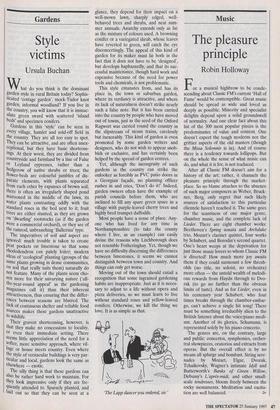Music
The pleasure principle
Robin Holloway
For a musical highbrow to be conde- scending about Classic FM's current 'Hall of Fame' would be contemptible. Great music should be spread as wide and loved as deeply as possible. Minority and specialist delights depend upon a solid groundswell of normalcy. And one clear fact about this list of the 300 most popular pieces is the predominance of value and content. One doesn't expect the tough moderns nor the grittier aspects of the old masters (though the Missa Solemnis is in). And of course there is a tendency towards lollipops. But on the whole the sense of what music can do, and what it is for, is not traduced.
After all Classic FM doesn't aim for a history of the art; rather, it channels the pleasure principle through the market- place. So no blame attaches to the absence of such major, composers as Weber, Bruck- ner, Berg, only regret that such likely sources of satisfaction to this particular clientele haven't reached it. The same goes for the scantiness of one major genre, chamber music, and the complete lack of Lieder. There are eight chamber works: Beethoven's Spring sonata and Archduke trio, Mozart's clarinet quintet, four works by Schubert, and Borodin's second quartet. One's heart weeps at the deprivation for just those music lovers to whom Classic FM is directed! How much more joy awaits them if they could surmount a few thresh- olds (no title, no soloist, no orchestra) more often — the untold wealth of melodi- ous rewards from Haydn through to Dvo- rak (to go no further than the obvious limits of taste). And as for Lieder, even in his centenary year Schubert, who four times breaks through the chamber-embar- go, can't achieve a single hit song! There must be something irreducibly alien to the British listener about the voice/piano medi- um. Another of its glories, Schumann, is represented solely by his piano concerto.
The genres are, on the contrary, large and public: concertos, symphonies, orches- tral showpieces, oratorios and extracts from operas. But the overall effect is by no means all splurge and bombast. String sere- nades by Mozart, Elgar, Dvorak, Tchaikovsky, Wagner's intimate Idyll and Butterworth's Banks of Green Willow, Debussy's L'apres-midi, and other small- scale tendresses, bloom freely between the rocky monuments. Meditation and excita- tion are well balanced. r.1- `Early music' is present only with Tallis's 40-part motet, Monteverdi's Vespers, and Purcell's Dido; the easy-listen baroque, by Pachelbel's Canon, Albinoni's Adagio, Allegri's Miserere, and The Four Seasons; and while the Handel tends towards the obvious (Hallelujah chorus, Water Music 'Handel's Largo') the Bach includes both the St Matthew Passion and the Goldberg Variations, summits respectively of inter- nalised affect and exploratory cerebration.
Haydn is the predictable Cinderella of the classical era, entering only at 154 with the trumpet concerto and notching up just one further score (but it is The Creation). Yet one could gain a reasonably represen- tative picture of Mozart and Beethoven from the repertoire chosen by 81,000 vot- ers. Chez Mozart two great choral torsos figure and two perfected du Ponte operas as well as a fair sample of orchestral music. For Beethoven, a line of major works (as well as beloved ephemera) which I give with their 1996 rating: Pastoral symphony (3), 'Ode to Joy' from the 9th (5); Emperor concerto (8); 5th symphony (19); 7th (25); violin concerto (32); Eroica (68); 4th piano concerto (110); 3rd (190); Fidelio (193); 8th symphony (285); which with the aforementioned Archduke trio (158) suggests a taste for high society as well as high thinking (the Missa Solemnis stands at 222).
But it is of course the 'Romantics' from Mendelssohn to Brahms, with 20th-century extensions into Elgar, Mahler, Rachmani- nov, Sibelius, Puccini, who provide the bulk. Brahms and Wagner enter unexpect- edly late — Brahms at 65 with the violin concerto and Wagner at 105 (Tannhauser overture) and thereafter (apart from the Idyll) is given only bleeding chunks.
Absences at the modem end are, by con- trast, unstartling. On this evidence the favourite modern composer is Vaughan Williams, with no fewer than seven slots. But the first choice for a 20th-century work goes (at 16) to Samuel Barber's A dagio for strings. It is followed by Rodrigo's guitar concerto (31) and Orffs Carmina Burana (35). Things improve. Favourites by Prokofiev and Ravel (Bolero) come within the first 100, together with the mild sting of Shostakovich's Gadfly and the glowing serenity of Strauss's Four Last Songs. The first 100 also includes (just) the solitary work by a living composer, Gorecki's once notorious third symphony (98). Two great not-so-modern ballet scores exemplify at 138-9 a tendency of the list to make off- rhyme couplets — The Rite of Spring! Appalachian Spring.
Last year Max Bruch both opened and closed the chart with his violin concerto in first place and his Kol Nidrei for cello and orchestra at 300. Beautifully crafted, euphonious, expressive, memorable; scarce- ly plumbing the depths or scaling the heights; unimpeachably musical from first note to last; the essence of middlebrow. One could do a lot worse.



































































 Previous page
Previous page